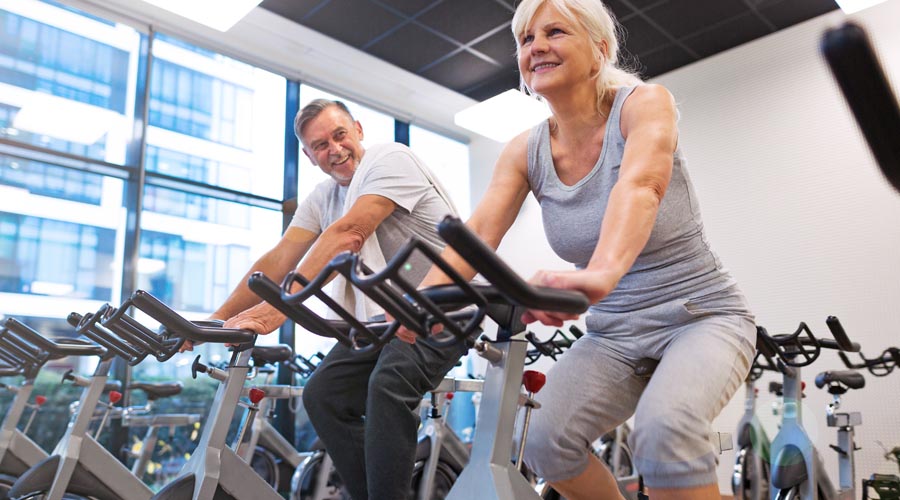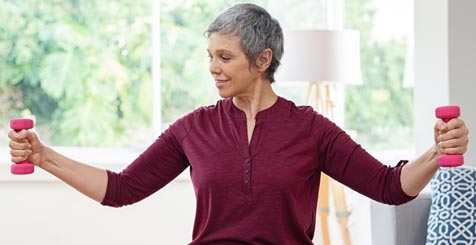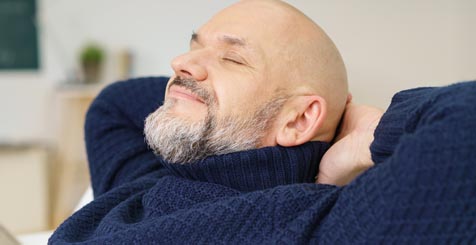A natural reaction for anyone experiencing pain caused by a musculoskeletal (MSK) condition such as arthritis or back pain is to rest up and sidestep activity. Although it might go against your instincts, the exact opposite is often a better solution for chronic pain (pain that lasts longer than three months – the normal amount of time tissue takes to heal). Here’s why exercise can help with pain management…
Chronic pain causes changes in the brain
With chronic pain, the nervous system stays on high alert, even when it doesn’t need to after an injury has healed. In the neural system, different cells (neurons) turn pain on and off – with chronic pain, the neurons that turn pain on are in charge and your body produces more pain-giving chemicals (glutamate) and fewer natural painkilling chemicals (natural opioids). But these changes to the nervous system aren’t permanent.
Chronic pain affects the immune system
Chronic pain causes the chemicals produced by the immune system to get out of balance, too, with more inflammatory cytokines and fewer anti-inflammatory cytokines. Again, these changes aren’t permanent.

Exercise improves pain control
Exercise can change how the body responds to pain and block pain signals to the brain. While you exercise, you calm the activity of pain-giving chemicals and neurons in the brain, which becomes lessened, while the chemicals that turn off pain, like serotonin and natural opioids, are more active.
Exercise changes the immune system too, by decreasing pain-producing chemicals and increasing pain-relieving chemicals. Anti-inflammatory cytokines promote tissue healing, too. So exercise balances out the ‘bad’ pain-giving chemicals with the good and normalises the processing of the body’s pain-giving signals. It also helps by stretching tense and stiff muscles, ligaments and joints.
Without exercise, your body will get out of shape
A few decades ago, if you suffered from chronic back pain you might have been told to lie down flat on a firm surface. Today, beyond a very short period of rest, your doctor’s advice will no doubt be to get up and about, to keep your muscles and joints moving. With back pain, for example, your muscles need to be in good shape to help to support your weight and provide cushioning. Both aerobic and strengthening exercises have been shown to decrease pain and fatigue and improve how the body functions.
It’s normal to feel anxious about exercising
You may well worry that exercising could make your pain worse, and the prospect of that could be enough to put you off. This is called ‘Fear Avoidance’ – and it’s a key factor in the continuation of chronic pain.
Add to that concerns of finding time to fit in new activity and not being able to reach a fitness goal and you may feel that there are a lot of barriers in the way of getting started. But regular exercise helps your body to become stronger and better at managing pain. It can help you to do more of what you enjoy with people you want to spend time with – and it’s unlikely to cause you any damage or harm.

Pain and your mental health
Depression, anxiety and other problems can go hand in hand with chronic pain. The endorphins released during exercise can help lift your mood, while keeping fit can help you to build a social network and give you a sense of achievement.
Take professional advice
Whether you have chronic pain stemming from your back, hip, knee, shoulder or neck, it’s always a good idea to get advice from your doctor before you start an exercise programme, and find an expert who can help adapt exercises to suit your particular condition and any posture problems. This will both protect you against injury and reassure you that exercising is safe – hurt does not equal harm in the case of sore muscles when you get started.
More research is needed
Perhaps surprisingly, there isn’t a huge amount of research available to show the success of exercise as a pain management tool. But the studies that have been carried out show that there are many benefits, including better muscle tone, strength and flexibility and improved overall quality of life.
People who exercise and stay flexible are shown to manage their pain much better than those who don’t. The benefits for your brain and body are well worthwhile so, as long as you have the go-ahead from your doctor, exercise is a positive step forward in managing chronic pain. After all, there’s a happier, healthier and more productive you to look forward to. If all that sounds good, read our blog for inspiration on 10 ways to get active with an MSK condition.
Medical information. This is provided for informational purposes only and is not meant to be a substitute for advice by a doctor or other qualified healthcare professional. Patients should not use the information on the Active Patients website for diagnosing a health or fitness problem or disease. Patients should always consult with a doctor or other health professional for medical advice or information about diagnosis and treatment. Never ignore professional medical advice because of something you have read on Active Patients.






